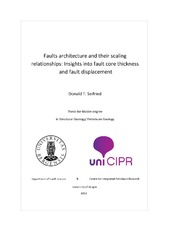Faults architecture and their scaling relationships: Insights into fault core thickness and fault displacement
Master thesis
Permanent lenke
https://hdl.handle.net/1956/6543Utgivelsesdato
2012-10-01Metadata
Vis full innførselSamlinger
- Department of Earth Science [1034]
Sammendrag
The purpose of this study is to investigate the statistical characteristics of fault core thickness and fault displacement, and to state the relationship between these two fault attributes. Field work was carried out At Tidwell Draw, in the San Rafael region of Utah, USA; and along the Moab Fault adjacent to the entrance to Arches National Park. Data from these sites were statistically analyzed, and exceedence frequency plots of fault core thickness and fault throw were drawn. These exceedence frequency plots were then redrawn on several scales, and graphical analyses were conducted to determine the frequency distribution of fault core thickness and fault throw. Following that, the data was then plotted together on a bivariate scatter plot, and analyzed for linear correlation in graphs of different scales. The data from the Moab Fault site was augmented with data gathered from photographs. Analysis suggests that results of data gathered from photographs can produce similar results and can be an acceptable method to obtain data from difficult locations. Results of these analyses reveal that fault throw at these locations is distributed following a power law distribution pattern, and that fault thickness tends to follow a log-normal distribution. Analysis of a global data base involving data from selected previously published works reveal that for many data sets, exceedence frequency plots of displacement reveal that frequency distribution tends to follow log-normal trends, rather than power law trends. The similar results display log-normal distribution for fault thickness as well. Emphasis is placed on the importance of analyzing EF plot in all scales in order to form the most accurate interpretation of data distribution Bivariate analysis of fault displacement and fault core thickness for the global data set exhibited a power law relationship with an exponent of 0,728 with a global goodness of fit regression of 74,2%. Although the data from Tidwell Draw displayed a regression of 52,0% for a power law relation with exponent value of 0,683, the data plotted consistent with the global plot. The data from the Moab Fault site also plotted consistent with the global plot. Although the Moab Fault data showed a weak regression for the power law relationship with exponent equal to 0,497, when the data was combined with another data set covering the upper ranges of the Moab Fault attributes, the combined Moab Fault data set showed a power law relationship with an exponent of 0,715 with a goodness of fit regression of 88,0%, exceeding the regression of both of the Moab Fault data sets and the global data set. This result indicates that 1) A large data set covering a broader range of displacement and fault core thickness will produce better results, and 2) data sets having most in common will produce better results when combined than data having least in common. This confirms a statement Evans, 1990 that for best results, data sets to be compared should be as similar as possible to avoid poor analysis.
